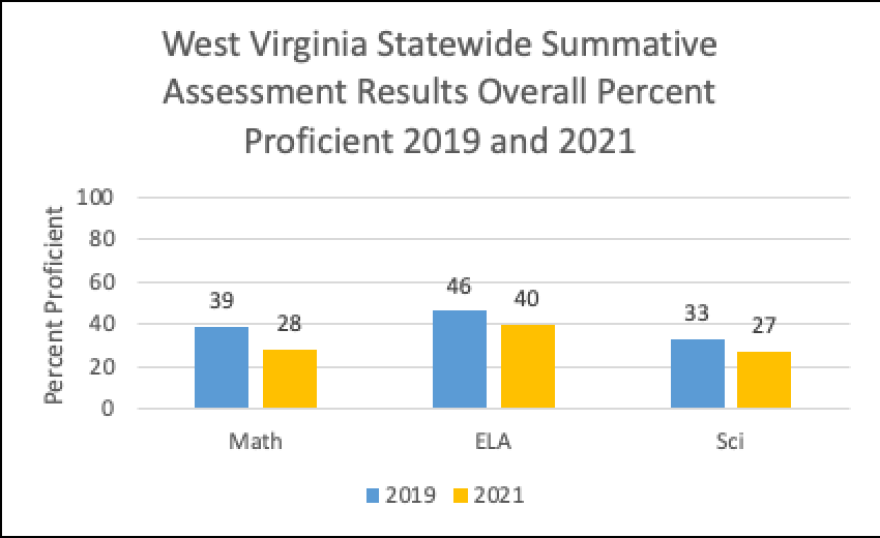State officials released student testing data for 2021 this week. Scores in math, science and English language dropped during the pandemic.
Students in grades 3 to 11 were tested this year.
Overall, 40 percent of West Virginia students were proficient in English language arts, down 6 percentage points from 2019. In science, 27 percent were found to be proficient — also down 6 points.
But math saw the greatest drop — down 11 percentage points from 2019 — showing a 28 percent proficiency rate.
The overall 2021 test results are a combination of three assessments: West Virginia General Summative Assessment in grades 3-8, the SAT School Day in grade 11 and the West Virginia Alternate Summative Assessment in grades 3-8 and 11.
Results are based on students who were enrolled full-time and in school for at least 135 days during the academic year.
Students were not tested in 2020 when the pandemic began.
This latest news adds to previous concerns about sagging achievement in the Mountain State. Prior to the pandemic, West Virginia students were already below the national average in all three subjects. That’s according to data from the National Assessment of Educational Progress, or NAEP. These tests are often referred to as the Nation’s Report Card.
State Superintendent of Schools Clayton Burch urged caution on making any direct comparisons between the pandemic year and previous years, saying the declines are not unique to the Mountain State.
“It’s going to be nationwide. It’s not going to be just here in West Virginia,” Burch said in the West Virginia Board of Education’s August meeting. “I mean, we continue to say we had nearly 50,000 children that were not in a brick-and-mortar school for nearly 18 months.”
Burch said test scores from this year will be used strictly to focus on COVID-19 recovery efforts and address individual student needs going forward.
State school board member Debra Sullivan agreed with Burch, saying the scores from 2021 are not the whole picture.
“A test is but a snapshot of a moment in time,” Sullivan said. “It’s not the whole child. It’s not the whole academic, intellectual capability or reflection of the whole child. It is a snapshot.”
Much of the dip in student performance was a result of participation rates, back-and-forth between remote and in-person classes, and learning disruptions over the past year-and-a-half, officials said.
This summer, thousands of students in West Virginia took part in a robust, summer school program called SOLE. More than $30 million was divided up among West Virginia counties. The program’s aim was to accelerate academic progress and address social-emotional and developmental losses.
“The journey through recovery will address the needs of the whole child – academics, well-being and developmental growth,” said Burch in a press release. “Districts are encouraged to look at the 2021 assessment results with an emphasis on individual student performance and use the information to construct the larger story of what is needed for meaningful recovery and growth.”
Additionally Wednesday, state school board members approved a limited waiver for this fall that allows all students for the first nine weeks of school access to extracurricular activities like sports, band and theater — regardless of GPA. Typically, a student must have at least a 2.0 to be eligible.
State school board members say the policy is to enable students who struggled to keep their grades up during the pandemic time to catch up.
“We do not see this limited waiver as an excuse for low academic performance, but instead an avenue for students to re-establish consistent engagement with their schools and benefit from the social-emotional, academic and extracurricular supports schools offer,” said WVBOE President Miller Hall in a statement. “These children have had so much taken away from them, and it is important that we look for ways to keep them connected so they can learn and thrive.”





















